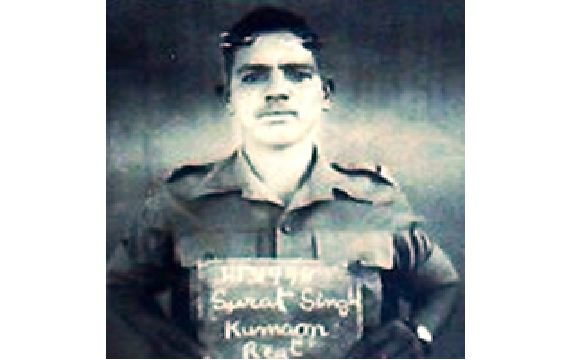
Service No : 4131998
Place of birth : Bhiwani Dist, (Har)
Service : Army
Last Rank : Naik
Unit : 13 Kumaon
Arm/Regt : The Kumaon Regiment
Operation : Indo-China War 1962
Martyrdom : November 18, 1962
Naik Suraj Singh
Naik Suraj Singh hailed from Bhiwani district in Haryana, a region known for its proud martial heritage and tradition of producing brave soldiers for the nation. From a young age, he displayed qualities of courage, determination, and patriotism, which led him to join the 13 Kumaon Battalion of the Kumaon Regiment, a battle-hardened infantry unit renowned for its exemplary bravery and distinguished service in numerous military operations. As a dedicated soldier, Naik Suraj Singh upheld the regiment’s rich legacy, earning the admiration and respect of his comrades through his unwavering commitment to duty. Beyond his military service, Naik Suraj Singh found immense strength and unwavering support in his family, especially his wife, Ms. Choten Devi, who stood firmly by his side through the challenges of military life.
Battle of Rezang La (Indo-China War): 18 Nov 1962
In June 1962, Naik Suraj Singh 's 13 Kumaon Battalion, under the command of Lt Col HS Dhingra, was moved from Ambala to Baramulla in J&K. In September 1962, as tensions with China escalated, the battalion was ordered to move to Leh on short notice. The 13 Kumaon Battalion was placed under the operational control of the 114 Infantry Brigade, commanded by Brigadier TN Raina (who later became the COAS). The brigade was tasked with defending approximately 400 km of the Indo-China border, including the Chushul area. Alongside 13 Kumaon, 114 Infantry Brigade had four other battalions under its command: 14 J&K Militia, 7 J&K Militia, 5 Jat, and 1/8 Gorkha Rifles. Naik Suraj Singh was functioning as part of 3-inch mortar section of 9th Platoon of Charlie Company, under the leadership of Major Shaitan Singh. As per the operational plan of 114 Infantry Brigade, 'C' Company of 13 Kumaon was deployed at Rezang La. Alpha Company, commanded by Maj GN Sinha, was the battalion reserve at the battalion HQ, located on high ground near Chushul. Bravo and Delta companies were stationed on Maggar Hill between Spanggur Gap and Rezang La Pass under the command of Capt RV Jatar. By 26 October 1962, Naik Suraj Singh and his comrades of 'C' Company had fortified their positions.
The platoons were deployed based on terrain and threat assessment to ensure an optimal tactical advantage. Platoons 7, 8, and 9 were positioned on the forward slopes of the hill: 7th Platoon, under Jemadar Surja Ram, held the northern flank; 8th Platoon, under Jemadar Hari Ram, occupied the pass area; and the central post was manned by 9th Platoon, under Jemadar Ram Chander, with the company HQ nearby. The mortar section, led by Naik Ram Kumar Yadav, was positioned on the reverse slope. The Chinese offensive in this sector began on 18 November, coinciding with the attack on Sela in the Northeast Frontier Agency (NEFA). A two-pronged assault was launched against the Chushul defenses. The northern prong targeted Gurung Hill, while the second targeted Charlie Company at Rezang La. Rezang La, situated approximately 11 km south of Spanggur Gap, was a critical position, as it dominated the road connecting Leh via Dungti, the lifeline for the Chushul garrison.
The first wave of attack came around 2:00 AM from the direction of Platoon 8, with a column of approximately 30 enemy soldiers. The movement was detected by the LP (Listening Post) of Platoon 8, and Jem Hari Ram was immediately informed by Section-1 commander Naik Hukam Chand. Jem Hari Ram alerted Capt Shaitan Singh and acted swiftly, instructing the Section-1 commander to move with an LMG detachment and halt the enemy's advance. When the enemy was about 50 yards away, Naik Hukam Chand ordered, "Fire." The surprise attack successfully repelled the first wave. The troops, including the section posts and mortar sections, were ready for the next assault. The second attack occurred at 4:00 AM, coming from the direction of Platoon 7. Jem Surja Ram quickly repositioned his 'Section-Three' to an alternate location and counterattacked the enemy with light machine guns, rifles, and grenades. Thanks to Jem Surja Ram and Naik Sahi Ram's section, the second wave was repelled. The enemy launched repeated attacks at regular intervals, increasing in intensity. Despite suffering losses of men and equipment, Naik Suraj Singh and his comrades, under Jem Ram Chander's leadership, held their ground until the sixth wave of attack at 7:40 AM.
The sixth wave was accompanied by heavy mortar shelling and the use of two MMGs from two fronts. After decimating 'Section-Three' of Platoon 9, the Chinese soldiers started edging towards the company HQs and the 3-inch mortar section manned by Naik Suraj Singh, Lance Naik Sri Ram, Lance Naik Roshan Singh and few other soldiers. When the Chinese soldiers were just 150 yards away, Naik Suraj Singh's mortar section had to fire at an elevation of almost 80 degrees. However, while Naik Suraj Singh was firing, he was hit by a splinter charge and was martyred. After the ceasefire, Rezang La fell into no man's land, disputed by both sides. The bodies of Naik Suraj Singh and other martyred soldiers of 13 Kumaon lay frozen at the site until they were discovered by a shepherd nearly three months later.
Naik Suraj Singh is survived by his wife Smt Choten Devi.

No Comments